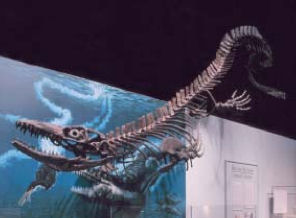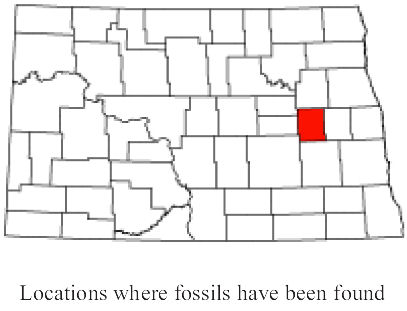Common Name:
Mosasaur
Classification:
Class: Reptilia
Order: Squamata
Family: Mosasauridae

This skeleton is of one of the mosasaurs called Plioplatecarpus that inhabited the Pierre Sea about 75 million years ago.

It was discovered in 1995 by Mike Hanson and Dennis Halvorson on Orville and Bev Tranby's farm in the Sheyenne River valley near Cooperstown, Griggs County, North Dakota.
Study of the nearly complete skull and other parts of the skeleton indicate that this is a new species of Plioplatecarpus that has not been found anywhere else in the world. The skeleton is 23 feet long. North Dakota State Fossil Collection ND 97-115.1. Beverly and Orville Tranby and Bev's sisters, Gloria Thompson, Jacqueline Evenson, and Susan Wilhelm, donated this fossil to the North Dakota State Fossil Collection for exhibit and study at the North Dakota Heritage Center.

Description:
Plioplatecarpus was one of the marine reptiles called mosasaurs. Mosasaurs
were huge marine lizards, up to 40 feet in length, that inhabited the world's
oceans during the Cretaceous. The name mosasaur means Meuse Reptile and
refers to the initial discovery of fossils of these animals in the 1770s
along the Meuse River near the town of Maastricht in the Netherlands.
Mosasaurs are related to monitor lizards, such as the Komodo dragon that
lives in Indonesia today. Unlike their terrestrial lizard relatives, the
limbs of mosasaurs were modified to form flippers. Mosasaurs swam by moving
the back part of their bodies and flattened tails from side to side. Their
flippers were used primarily for steering rather than for propulsion as the
animal glided through the water. Mosasaurs were active predators and among
the main carnivores in the Cretaceous oceans. They had a good sense of sight
and a poor sense of smell. They probably preyed on other mosasaurs, fish,
turtles, and invertebrates, such as cephalopods. Although mosasaurs were not
dinosaurs, they became extinct at the same time as the dinosaurs, about 65
million years.

This painting, by David Miller, is a depiction of an animal community that lived in the shallow-water, subtropical Pierre Sea that covered North Dakota about 75 million years ago. The scene is based on fossils found in the Pierre Formation at a fossil site near Cooperstown, Griggs County. The large, predatory mosasaur, Plioplatecarpus, is attacking the diving seabird, Hesperornis. Hesperornis has just captured a salmon-like fish, Enchodus. In the background, a carcass of another decaying Plioplatecarpus is being scavenged by a frenzied group of dogfish sharks, Squalus. The large sand-tiger shark, Carcharias, cruises near the sea floor.
The original html was found on this Department of Mineral Resources site on January 20, 2012.